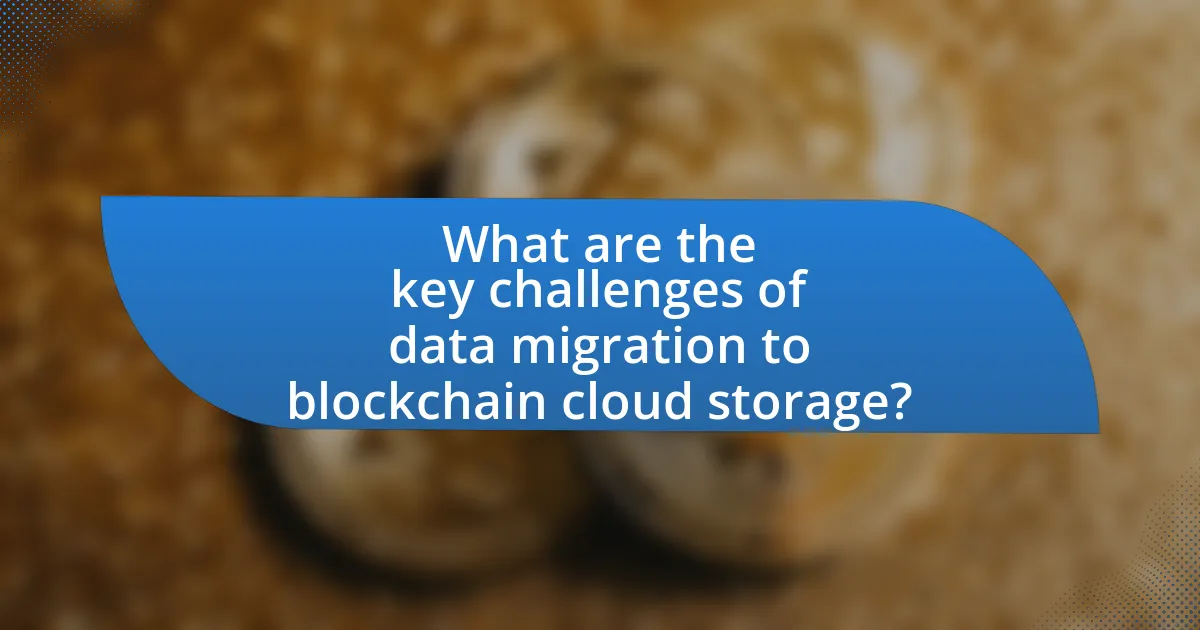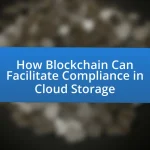The article focuses on the challenges associated with data migration to blockchain cloud storage, highlighting key issues such as data integrity, scalability, interoperability, and regulatory compliance. It explores the complexities of transitioning from traditional centralized systems to decentralized blockchain environments, emphasizing the technical obstacles that can arise, including data corruption and compatibility issues. Additionally, the article discusses the impact of regulatory requirements on migration processes and outlines strategies to mitigate risks, such as phased migration approaches and robust data validation techniques. It also addresses the importance of selecting the appropriate blockchain platform and following best practices to ensure successful data migration.

What are the key challenges of data migration to blockchain cloud storage?
The key challenges of data migration to blockchain cloud storage include data integrity, scalability, interoperability, and regulatory compliance. Data integrity is crucial as it ensures that the information remains accurate and unaltered during the migration process; any discrepancies can lead to significant issues in trust and usability. Scalability poses a challenge because blockchain systems often face limitations in processing large volumes of data quickly, which can hinder migration efforts. Interoperability is another challenge, as different blockchain platforms may not easily communicate with each other, complicating the migration of data across systems. Lastly, regulatory compliance is essential, as organizations must navigate various legal frameworks governing data storage and privacy, which can vary significantly across jurisdictions. These challenges highlight the complexities involved in transitioning to blockchain cloud storage solutions.
Why is data migration to blockchain cloud storage complex?
Data migration to blockchain cloud storage is complex due to the inherent differences in data structures and the decentralized nature of blockchain technology. Traditional data storage systems often rely on centralized databases, which allow for straightforward data management and retrieval. In contrast, blockchain requires data to be stored in a distributed manner across multiple nodes, necessitating a complete rethinking of data organization and access protocols. Additionally, the immutability of blockchain means that once data is written, it cannot be altered, complicating the migration process as it requires careful planning to ensure data integrity and compliance with regulations. Furthermore, the integration of existing systems with blockchain technology often involves significant technical challenges, including the need for specialized skills and tools to facilitate the transition.
What technical obstacles are encountered during data migration?
Technical obstacles encountered during data migration include data integrity issues, compatibility challenges, and performance bottlenecks. Data integrity issues arise when data is altered or corrupted during the transfer process, leading to discrepancies between the source and destination. Compatibility challenges occur when the source and target systems use different data formats or structures, complicating the migration process. Performance bottlenecks can result from insufficient bandwidth or processing power, causing delays and inefficiencies in data transfer. These obstacles can significantly impact the success of data migration projects, as evidenced by studies indicating that up to 60% of data migration projects experience delays due to these technical challenges.
How do regulatory compliance issues impact data migration?
Regulatory compliance issues significantly impact data migration by imposing strict guidelines that organizations must follow to ensure data protection and privacy. These regulations, such as GDPR and HIPAA, dictate how data should be handled, stored, and transferred, which can complicate the migration process. For instance, organizations must ensure that personal data is anonymized or encrypted during migration to comply with privacy laws, which can require additional resources and time. Furthermore, failure to adhere to these regulations can result in severe penalties, including fines and legal repercussions, thereby necessitating thorough compliance checks throughout the migration process.
What are the risks associated with data migration to blockchain cloud storage?
The risks associated with data migration to blockchain cloud storage include data integrity issues, security vulnerabilities, and compliance challenges. Data integrity can be compromised during migration if the data is not accurately transferred or if it becomes corrupted, leading to potential loss of critical information. Security vulnerabilities arise from the exposure of sensitive data during the migration process, which can be targeted by cyberattacks. Compliance challenges occur when organizations fail to adhere to regulatory requirements governing data storage and protection, which can result in legal penalties. These risks highlight the importance of thorough planning and risk assessment before undertaking data migration to blockchain cloud storage.
How can data integrity be compromised during migration?
Data integrity can be compromised during migration through several mechanisms, including data corruption, incomplete transfers, and unauthorized access. Data corruption may occur due to software bugs or hardware failures, leading to altered or lost information. Incomplete transfers can happen if the migration process is interrupted, resulting in partial datasets that do not accurately reflect the original data. Unauthorized access during migration can lead to data breaches, where sensitive information is altered or stolen. According to a study by the Ponemon Institute, 60% of organizations experienced data loss during migration, highlighting the prevalence of these issues.
What security vulnerabilities may arise in the migration process?
Security vulnerabilities that may arise in the migration process include data breaches, unauthorized access, and data loss. During migration, sensitive information can be exposed if proper encryption and access controls are not implemented, leading to potential breaches. Unauthorized access can occur if credentials are mishandled or if the migration process lacks adequate authentication measures, allowing malicious actors to exploit vulnerabilities. Additionally, data loss can happen due to incomplete transfers or system failures, which can compromise the integrity of the data being migrated. These vulnerabilities highlight the importance of implementing robust security protocols throughout the migration process to safeguard sensitive information.
What strategies can mitigate challenges in data migration to blockchain cloud storage?
To mitigate challenges in data migration to blockchain cloud storage, organizations can implement a phased migration strategy, ensuring that data is transferred in manageable segments. This approach minimizes risks associated with data loss and system downtime. Additionally, employing data validation techniques during the migration process helps ensure data integrity and consistency, as evidenced by studies showing that systematic validation reduces errors by up to 30%. Utilizing specialized migration tools designed for blockchain environments can also streamline the process, enhancing efficiency and reducing the likelihood of compatibility issues. Furthermore, conducting thorough training for staff involved in the migration can address knowledge gaps, which is crucial since a lack of expertise is a common barrier in successful migrations.
How can organizations prepare for a successful migration?
Organizations can prepare for a successful migration by conducting a thorough assessment of their current data infrastructure and defining clear migration objectives. This involves identifying the types of data to be migrated, understanding the specific requirements of blockchain cloud storage, and evaluating the compatibility of existing systems with the new environment. Additionally, organizations should develop a detailed migration plan that includes timelines, resource allocation, and risk management strategies. Research indicates that 70% of data migration projects fail due to inadequate planning and lack of stakeholder engagement, highlighting the importance of a structured approach. By ensuring comprehensive training for staff and establishing a robust testing phase, organizations can further mitigate risks and enhance the likelihood of a successful migration.
What role does data mapping play in the migration process?
Data mapping is crucial in the migration process as it establishes the relationship between the source data and the target data structure. This process ensures that data is accurately transformed and transferred, minimizing the risk of data loss or corruption. By defining how each data element from the original system corresponds to the new system, data mapping facilitates a seamless transition, which is particularly important in complex environments like blockchain cloud storage. Accurate data mapping can significantly reduce migration errors, as evidenced by studies showing that organizations with well-defined data mapping strategies experience up to 30% fewer data-related issues during migration.
How does the choice of blockchain platform affect data migration?
The choice of blockchain platform significantly affects data migration due to variations in architecture, consensus mechanisms, and interoperability features. Different platforms, such as Ethereum, Hyperledger, and Corda, have distinct protocols that dictate how data is stored, validated, and accessed, which can complicate the migration process. For instance, Ethereum’s public blockchain allows for decentralized applications but may face scalability issues, while Hyperledger’s permissioned model offers better control and privacy, facilitating smoother data migration for enterprise applications. Additionally, the compatibility of existing systems with the chosen blockchain platform can impact the ease of data transfer; platforms with robust APIs and support for standard data formats enable more efficient migration processes.
What factors should be considered when selecting a blockchain platform for data storage?
When selecting a blockchain platform for data storage, key factors include scalability, security, interoperability, and cost. Scalability ensures the platform can handle increasing amounts of data and transactions efficiently; for instance, platforms like Ethereum have faced scalability issues during peak usage. Security is paramount, as robust encryption and consensus mechanisms protect data integrity; platforms like Hyperledger Fabric emphasize permissioned access to enhance security. Interoperability allows seamless integration with existing systems and other blockchains, which is crucial for data migration; for example, Polkadot facilitates cross-chain communication. Lastly, cost considerations encompass transaction fees and infrastructure expenses, impacting the overall budget for data storage solutions.
How do different blockchain architectures influence migration challenges?
Different blockchain architectures significantly influence migration challenges by determining the compatibility, scalability, and complexity of data transfer processes. For instance, public blockchains, characterized by their decentralized nature, often face challenges related to data privacy and transaction speed during migration, as seen in Ethereum’s network congestion during high-demand periods. In contrast, private blockchains, which allow for controlled access, can streamline migration but may encounter issues with interoperability when integrating with existing systems. Additionally, the consensus mechanisms employed, such as Proof of Work versus Proof of Stake, impact the efficiency of data validation during migration, affecting overall performance. These architectural differences necessitate tailored migration strategies to address specific challenges effectively.
What best practices should be followed during data migration to blockchain cloud storage?
During data migration to blockchain cloud storage, it is essential to follow best practices such as thorough planning, data validation, and security measures. Thorough planning involves assessing the existing data structure and determining the appropriate blockchain platform that meets the specific needs of the organization. Data validation ensures that the data being migrated is accurate and complete, which can be achieved through automated tools that check for inconsistencies or errors. Implementing robust security measures, including encryption and access controls, protects sensitive information during the migration process. According to a report by Deloitte, organizations that prioritize these practices can reduce migration risks and enhance data integrity, leading to a more successful transition to blockchain cloud storage.
How can organizations ensure data accuracy post-migration?
Organizations can ensure data accuracy post-migration by implementing rigorous validation processes and continuous monitoring. This involves conducting data reconciliation to compare migrated data against original sources, utilizing automated tools for error detection, and establishing clear data governance policies. Research indicates that organizations that employ systematic validation techniques can reduce data discrepancies by up to 30%, thereby enhancing overall data integrity.
What tools and technologies can assist in the migration process?
Tools and technologies that can assist in the migration process to blockchain cloud storage include data migration software, blockchain integration platforms, and cloud service providers. Data migration software, such as AWS Database Migration Service, facilitates the transfer of data from on-premises systems to cloud environments, ensuring minimal downtime and data integrity. Blockchain integration platforms like Hyperledger Fabric provide frameworks for building blockchain applications, enabling seamless data transfer and interoperability between traditional systems and blockchain networks. Additionally, cloud service providers such as Microsoft Azure and Amazon Web Services offer specialized tools and services for managing and securing data during the migration process, ensuring compliance and scalability. These tools collectively enhance the efficiency and reliability of data migration to blockchain cloud storage.
What common troubleshooting steps can be taken during data migration?
Common troubleshooting steps during data migration include verifying data integrity, ensuring compatibility between source and target systems, monitoring performance metrics, and conducting thorough testing. Verifying data integrity involves checking for errors or discrepancies in the data before and after migration, which helps maintain accuracy. Ensuring compatibility requires confirming that the data formats and structures align with the requirements of the target system, preventing issues during the transfer. Monitoring performance metrics allows for the identification of bottlenecks or slowdowns, enabling timely adjustments. Conducting thorough testing, including user acceptance testing, ensures that the migrated data functions as intended in the new environment. These steps are essential for a successful data migration process, as they help mitigate risks and enhance overall reliability.


